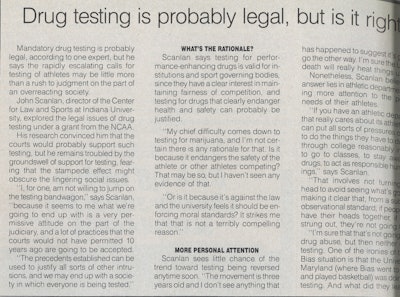This article originally appeared in the September 1986 issue of AB with the title, “Is Drug Testing Legal?”
When Len Bias, the sure-bet NBA star of the future, collapsed in his dorm room that grim early morning in June, the cresting tide of support for drug testing of college athletes swelled perceptively.
Critics and detractors of mandatory testing persist, but public and media outrage over the cocaine-induced death of a bright and rising star has quieted much of the opposition. Fewer people seem willing to stand on previous ethical objections, while proponents cite the tragedy as evidence that testing is needed to protect the health and safety of young athletes.
Law school professor John Scanlan, who has studied the legal issues involved in drug testing, says that growing public sentiments for testing may also be translated into judicial willingness to supports its legality, making it easier for public institutions to defend against legal challenges to testing policies.
That could prove to be a key development, as increasing numbers of universities are stablishing drug testing programs for their intercollegiate athletes. A survey by the NCAA Drug Education Committee found that 17 percent of the 517 schools surveyed already employed drug testing, and another 13 percent planned to soon.
“All the recent publicity about cocaine deaths (of Bias and Cleveland Browns’ defensive back Don Rogers), certainly puts universities in a stronger position now than they were a year ago as far as citing safety reasons for testing for cocaine,” says Scanlan, who is director of the Center for Law and Sports at the Indiana University Law School in Bloomington.
Many Employers Testing
Universities are not alone in their involvement in drug testing. Especially noteworthy has been the growth in testing by employers, who say drug abuse is costing them billions of dollars a year in accidents, absenteeism and decreasing productivity.
One estimate indicated that as many as 40 percent of the largest U.S. employers have begun or plan to implement some form of drug testing for prospective or existing employees.
Government employees are increasing targets for drug testing. A presidential commission earlier this year recommended drug testing for federal employees. Already, many local governments require testing of police and fire recruits, and the U.S. Armed Forces have tested for years.
In 1985, three million drug tests were performed on the nation’s 2.1 million servicemen.
Athletes in the Spotlight
But, because of their high visibility, athletes’ drug use has attracted the most attention.
After American athletes were disqualified at the 1983 Pan Am Games in Caracas, Venezuela, the U.S. Olympic Committee instituted random testing for steroids and other performance-enhancing drugs. Ten athletes tested positive during trials for the 1984 Olympics, but no Americans tested positive at the Games.
Professional sports have had more difficulty establishing testing programs, primarily because of opposition from player unions. Many believe the death of Rogers, combined with the cocaine scandals in major league baseball during the 1984 and 1985 seasons, will soon overcome that opposition.
In July, the National Association of Intercollegiate Athletics adopted a policy requiring each of its 500 members, as a condition of continued membership, to begin testing athletes for drug use.
That followed a vote in January by the NCAA to begin testing at football bowl games and championship events. Just one year earlier, the proposal was referred back to committee for more study, and opposition appeared strong.
The NCAA’s decision is expected to encourage more universities to establish testing programs.
“I would assume that as a result of the NCAA decision, virtually every university with a major athletic program will eventually be doing drug testing,” says Scanlan.
While Olympic testing is interested only in performance-enhancing drugs, the NCAA program, and those of individual institutions, are also geared for “recreational” drugs such as marijuana and cocaine. Previously, many NCAA members believed that such testing was not a legally defensible as testing for performance-enhancing drugs.
Murky Legal Waters
In truth, the legality of testing remains shrouded in uncertainty, so much so that the NCAA asked Scanlan to study the legal issues.
In the private sector, at least two multimillion-dollar lawsuits have been filed by employees whose tests were positive for drug use, but who claim the tests were wrong.
A U.S. District Court judge last year enjoined the Arkadelphia, Ark., School District form using urinalysis in its drug testing program, although he left the remainder of the program intact. On the other hand, another U.S. District Court judge upheld use of urinalysis and breathalyzers in random testing of jockeys by the New Jersey Racing Commission.
Scanlan says the issues have not been resolved because there is not enough case law to provide a reliable precedent, be he expects that such precedents will be established quickly as the sentiment for testing spreads, and as legal challenges to testing increase accordingly.
Privacy, Incrimination Issues Weak
The weakest challenges may come from athletes who claim “the school doesn’t have a right to look into my personal life,” or that testing requires the individual to incriminate him- or herself, says Scanlan.
“Phrased in those general terms, there really isn’t a strong constitutional argument that can be made. When the courts talk about privacy, they tend to do so within fairly restrictive contexts, such as marital privacy, birth control and abortion,” says Scanlan.
“They have been very reluctant to find a more general privacy right, so I don’t think an athlete is going to get very far with that.”
More likely, problems with privacy will arise from statures governing the release of educational records, so institutions may have to take precautions to prevent the dissemination of test results.
The self-incrimination challenge, based on the Fifth Amendment, is also unlikely to be supported by the courts, says Scanlan, because self-incrimination has generally been applied only to testimonial evidence, not physical evidence.
Besides, says Scanlan, “the principles of self-incrimination are rarely applied outside of criminal proceedings, and drug testing of athletes is not a criminal proceeding.”
What is a Reasonable Search?
A slightly stronger, though still suspect, challenge could come under the Fourth Amendment right to protection from “unreasonable search and seizure,” without a warrant.
Defense for testing hinges on the issue of consent, and most of the institutions who do testing say they are making consent to testing a precondition of accepting an athletic scholarship.
“I don’t know whether that argument will fly, since it hasn’t been litigated,” says Scanlan, “but the schools are acting under the belief that courts will say there is nothing wrong with compelling consent.”
One thing that is certain, says Scanlan, is that “schools that don’t make consent to testing a precondition of participation are going to have difficulty justifying the tests.”
Selectivity Must Be Justified
Although there may be good reasons for testing athletes and not other students, those reasons need to be articulated to show “there is adequate reason for differentiating one group from another,” says Scanlan.
“Adequate,” however, is a highly relative term, and the strength of the rationale required depends on how the group is defined.
“If a school would choose, for instance, to test only blacks, or only Catholics or only Jews, it would have to demonstrate a very compelling reason for doing so, which is something it probably could not do,” says Scanlan.
“With athletes, the classification itself is not suspect, so as a result the institution would simply have to demonstrate some rational basis for selecting athletes.
“That should not be terribly difficult,” says Scanlan, “but it does require the institution to think through why it is testing athletes, what its objectives are and whether those objectives are relevant to the testing.”
Rules Tougher for High Schools
High Schools may face more difficulty in justifying drug testing than colleges. One of the objections raised in the Arkadelphia ruling was that the urinalysis could not distinguish when the drug was taken, and therefore was “an attempt to regulate out-of-school conduct.”
The same objections could be encountered at the college level, but it is likely that a court will consider participation in intercollegiate athletics a privilege, whereas high school education is a right.
“If the result of a drug test is to suspend the student from high school, there is no question that he or she has been deprived of a property interest,” says Scanlan.
“On the other hand, if you suspend a player form intercollegiate athletics, even if he or she is a potential professional athlete, a court will be more reluctant to recognize a constitutionally protected property interest, and therefore will look less searchingly at testing than it would in a high school context.
Test Accuracy Is Key
The issue of accuracy is perhaps the most troubling aspect of drug testing. A study last year of 13 drug-testing laboratories by the national Centers for Disease Control found that as many as 66 percent of the samples tested showed “false positives,” and that the tests failed to detect drugs in other samples that did contain drugs.
Scanlan finds such data “disturbing,” but notes that accurate testing devices are available, if more expensive, and that some schools approach the problem by screening with the less accurate, less expensive tests. Those who test positive can be asked to submit to the more accurate testing process.
The University of Georgia, a pioneer now in its fourth year of testing, takes that approach, using on-site screening to identify possible users. That finding is confirmed by a laboratory analysis.
Georgia’s policy is primarily aimed at counseling young athletes with problems. The first positive test requires the athlete to seek counseling. Suspension from sports is at the discretion of the coach, though a week is recommended.
A second positive test may bring a somewhat stiffer suspension, still at the discretion of the coach, and a third positive brings an automatic minimum of a one-year suspension.
Veteran head trainer Warren Morris, who administers the program, says he was initially skeptical, but has become a believer.
“We think it’s working very well,” says Morris. “We listen to what the coaches and other athletes tell us. A past positive or someone we believe is a user will be tested every week, and we tell them that.”
“We give them a reason to say no. Once they find out the machinery really works, that we can identify them, they have to change their lifestyles.”
Scanlan says he is personally opposed to mandatory testing, but concedes that “properly designed, most of these testing programs are going to withstand judicial scrutiny, provided they use accurate testing devices, establish reasonably clear and specific objectives and obtain the proper prior consent.”
Additional Article:





































